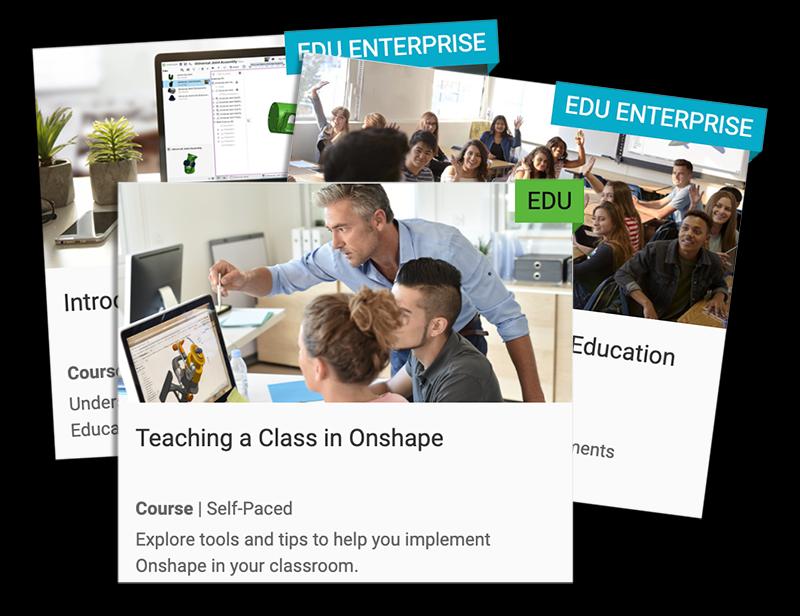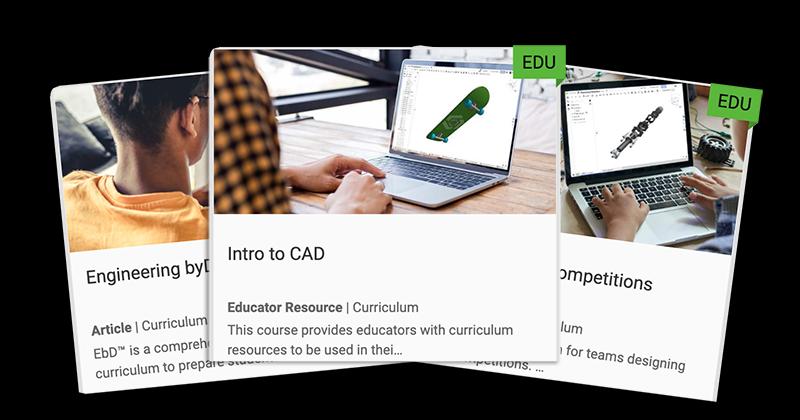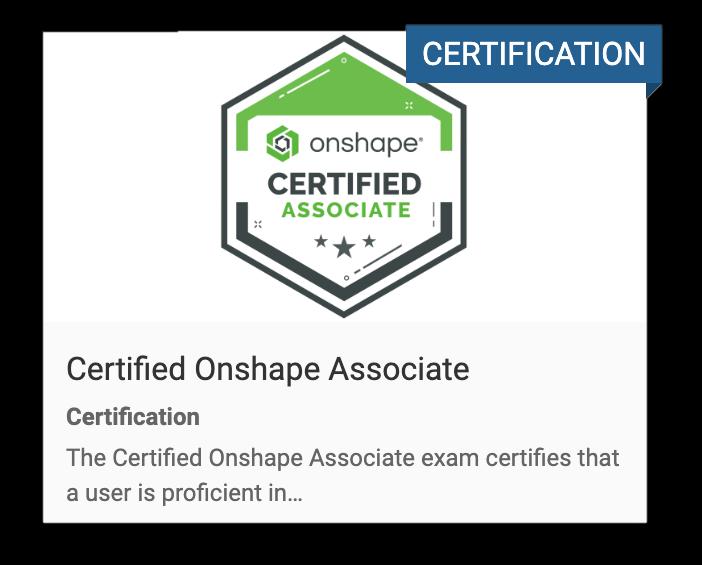
07:32
As the school year approaches, many educators seek ways to refresh their curriculum and bring new ideas to the classroom.
Thankfully, the Onshape Learning Center offers content to help with both. Materials such as self-paced courses, a robust Bootcamp, and a complete “Intro to CAD” curriculum help everyone from novices to CAD wizards.
With so much content, you may wonder where to begin and where to keep digging. Let's jump in and go over our recommended workflow for educators who are new to Onshape.
Explore Learning Pathways and Self-Paced Courses
The Onshape Learning Center includes several self-paced courses. Courses are available in a standalone format or in the form of Learning Pathways, which are compilations of self-paced courses organized into an instructional sequence.
Some pathways provide a general overview of CAD and Onshape, while others dive more deeply into specific functions and features. For new users such as students (or even educators trying Onshape for the first time), there are four primary pathways we recommend based on experience and user feedback:
- CAD Basics
- Onshape Fundamentals
- Teaching a Class in Onshape
- Classes & Assigments
CAD Basics. Whether it’s your first time using CAD or you have years of experience using another CAD program, the courses in the “CAD Basics” pathway are the best way to quick-start the learning process. Seasoned CAD users will learn how to transfer their existing knowledge to Onshape, and those just beginning their CAD journey will get more comfortable with the unique Onshape interface and build the foundation for continued learning.
Whether you believe you fall within one of these groups or somewhere in between, the “CAD Basics” learning pathway will help you better understand the Onshape way of product development.
Onshape Fundamentals. For those looking to build on what they learned in the “CAD Basics” pathway or who feel confident in their basic CAD skills and understanding already, there is a more detailed pathway called “Onshape Fundamentals.” This pathway dives deeper into Part Studio, Assembly Studio, and Drawings to strengthen your foundation of knowledge.
With both pathways – “CAD Basics” and “Onshape Fundamentals” – many educators will use the pathways to get familiar with Onshape themselves or just get familiar with the content before assigning their students to complete the pathway(s). These two pathways are a popular choice for helping new learners get started with Onshape, whether they are students or instructors. Additionally, course progress is tracked in your activity dashboard. This means you can ask your students for the certificate of completion as proof they finished an assigned course or pathway.
Teaching a Class in Onshape. Located in the Educator Resources section of the Learning Center, “Teaching a Class in Onshape” was created specifically for educators who were using the Onshape Education Standard plan, now known as the Onshape Student plan. It contains teacher tips and recommendations for how to best organize Onshape for use in the classroom. This includes how to get your students signed up for Onshape, how to distribute and receive student work, and how to use teams and folders to separate work for multiple classes.
Classes & Assignments. For teachers who are using the Onshape Educator Plan or are teaching at a school with an Onshape Education Enterprise, this course is for you. It contains information on how to set up your classroom, how to create individual classes for each course you teach, and how to best use the assignment system to distribute and receive student work.
For those that like to learn at their own pace, our learning pathways may be the best way to get started with Onshape. However, there are other methods of CAD education we offer.

Instructor-Led Training: Onshape Bootcamp
If you are coming to Onshape from a traditional file-based CAD program and are looking to learn the ins and outs of Onshape as fast as possible, then the Onshape Bootcamp is for you.
Onshape Bootcamp is designed to teach you all of the unique features that separate Onshape from the rest. Some of these unique features include; Multi-part modeling, Mating in Assemblies, Document Versions and History, Branching and Merging, and Onshape’s own programming language, FeatureScript.
The instructor-led bootcamp is a 10-hour course spread over four consecutive days. It’s held through video conferencing with a limited class size and live instruction from our Onshape experts. This allows you to ask questions as they arise so you can stay focused on the material. While the instructor-led training is a paid course, Onshape Bootcamp is also offered as a free self-guided course without instructors. This is best for those that like to learn at their own pace but still want to learn all the new features of their new product development platform.
Curriculum: ‘Intro to CAD’ and ‘CAD for Robotics Competitions’
In addition to self-paced content, educators can also take advantage of our custom curriculum, designed by teachers for teachers. Complete curriculum offerings include “Intro to CAD” and “CAD for Robotics Competitions.” Once you have chosen your path and feel more comfortable using Onshape, we recommend taking a look at our “Intro to CAD” curriculum. It was designed to be a semester's worth of work and is suitable for K-12 to university-level students who have not used CAD before.
The “Intro to CAD” curriculum is broken down into five separate units, all based on different types of Onshape projects. The first unit begins with an introduction to the Onshape interface and teaches students how to navigate through a 3D space. This is done through a fun scavenger hunt exercise. Unit 2 moves into modeling parts of a skateboard and assembling them. The third Unit touches on Drawings, Configurations, and Custom Features. Unit 4 is a collaborative project where two students create parts of a pull copter that can optionally be 3D printed and assembled.
After going through the first four units, students are encouraged to get creative with their new CAD abilities and create a custom phone mount. These units combine to make roughly nine weeks' worth of content.
The curriculum contains all of the supporting resources needed to help run a class, such as teacher guides, student guides, and slide decks for each lesson within the units. These are all editable Google Docs that you can customize. There are pre-made Onshape Documents to go along with each lesson. They contain a tab with PDF instructions along with the applicable Part Studio and Assembly Studio tabs that may be part of each lesson. These resources combine to create an engaging and cohesive experience for students and instructors.
“The ‘Intro to CAD’ curriculum is exactly what I would have loved to use while I was in the classroom with my own students,” said educator and PTC Senior Education Curriculum Development Specialist Naomi Edwards. “When you have so little time to prepare thoughtful activities for students, this kind of resource can really elevate what you can accomplish in the classroom.”
There are also many units within the “CAD for Robotics Competitions” curriculum for schools with robotics classes and teams. They cover specific competitions, including FIRST and VEX Robotics, and go over topics like assembling a drivetrain, creating custom components, manufacturing, and data management overviews. Each unit has a separate Onshape Document for FRC, FTC, and VEX teams to provide the most relevant content possible and cater to the growing use of Onshape in these competitions. Educators can leverage these units in the classroom.
“This curriculum strives to teach more than just skills to students. We worked hard to help students understand design intent throughout,” Edwards said.

Onshape Associate Certification
After going through the “Intro to CAD” curriculum and getting more modeling experience, some educators offer the Onshape Associate Certification to their students. It is an industry-recognized certification that students can put on their resume to show off their new CAD skills.
The certification covers general CAD knowledge as well as Onshape-specific concepts. Part Studios, Assemblies, Drawings, and Sharing & Collaboration are all topics you will see in the exam; it is essential to be familiar with them before you take the exam. Once you have completed the “CAD Basics” and “Onshape Fundamentals,” Bootcamp, or “Intro to CAD” and have some more modeling time under your belt, you are almost ready to take the exam. The Certified Onshape Associate Practice Exam is the best way to prepare for the certification exam. This free resource provides information and tips to pass the exam on the first try.

The Onshape Learning Center contains a wide range of materials designed to serve our broad and diverse education audience and anyone looking to learn Onshape anywhere in their CAD journey.
The Onshape Learning Center
Take self-paced courses, get technical briefings, or sign up for an instructor-led training session.
For those working in education, sign up for our free Education Standard Plan to keep track of your learning center progress.
Latest Content

- Case Study
- Industrial Equipment & Machine Design
Reframe Systems: Transforming Homebuilding with Digital Automation and Cloud-Native Onshape
09.25.2025 learn more
- Blog
- Aviation, Aerospace & Defense
- Branching & Merging
- Custom Features
- Learning Center
- Onshape Government
Why Aerospace & Defense Teams Choose Onshape for Product Development
12.18.2025 learn more
- Blog
- Evaluating Onshape
Cloud-Native CAD 2025 Wins: Revenue Growth, Real-Time Collaboration, Unified CAD-CAM
12.17.2025 learn more
- Blog
- Becoming an Expert
- Assemblies
- Simulation
Mastering Kinematics: A Deeper Dive into Onshape Assemblies, Mates, and Simulation
12.11.2025 learn more



